CES2004 Mike Wright
2004 Consumer Electronics Show – Part 3
Michael Wright
“So this is Las Vegas,” I thought to myself as the plane landed. All of the colorful lights displayed on and around all of the hotels and casinos—this being my first trip to Vegas—had me impressed to the point that me and my roommate, fellow Stereo Timer Dave Thomas, discovered too late that there was only one bed in our room and that one of us would be sleeping on a cot. Great. Getting to the exhibits the next morning wasn’t that much better due to what seemed to be a shortage of cabs. Finally, Dave and I made it to the Alexis Park and after picking up our badges, began to make our rounds. As this was my first show in some official capacity, and since this would be my first “show report”, I was thrilled to find some very interesting rooms.
The Thiel room was the first one I visited that I thought sounded okay. I have been to shows where they really put a lot of effort into making their room sound good and there was no complaint here for this year’s effort. Powered by Balanced Audio Technology electronics, their CS 2.4 speakers ($3,900) and SW1 subs ($4,800) made a nice match. Going back there the next day, I noticed that the stage the speakers threw had become larger and deeper and the vocalists appeared to be more in the room than I had noticed the day before. I’m beginning to understand what it means to listen under “show conditions.”
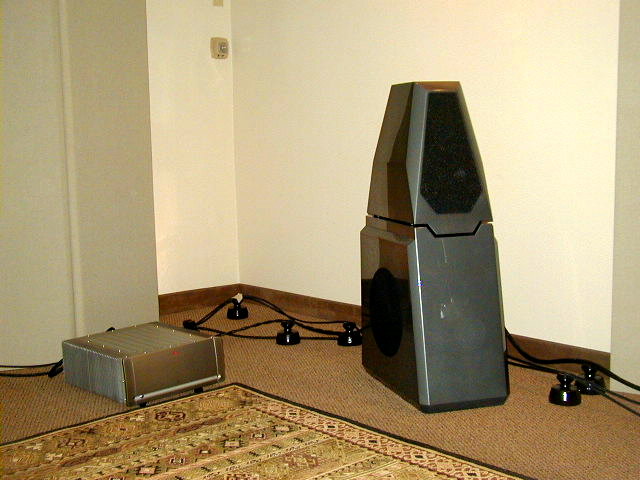 Also sounding good, for the short amount of time I was there, were Parasound’s Halo JC-1 monoblocks ($6,000) being fed by the legendaryCTC Blowtorch preamp ($18,000). However, I was just getting into the music when a gentleman, who reviews for a “larger” publication came in and was afforded use of the entire room for his own private listening session. So please, don’t ask what the rest of the system was because I didn’t make it back there. What I did enjoy even more was having the opportunity to chat with Blowtorch designer, Bob Crump, about his wonderful preamp. After a little time spent engaging him in conversation, I could see why some people say his preamp is one of the best in the world.
Also sounding good, for the short amount of time I was there, were Parasound’s Halo JC-1 monoblocks ($6,000) being fed by the legendaryCTC Blowtorch preamp ($18,000). However, I was just getting into the music when a gentleman, who reviews for a “larger” publication came in and was afforded use of the entire room for his own private listening session. So please, don’t ask what the rest of the system was because I didn’t make it back there. What I did enjoy even more was having the opportunity to chat with Blowtorch designer, Bob Crump, about his wonderful preamp. After a little time spent engaging him in conversation, I could see why some people say his preamp is one of the best in the world.
Fabulous Imports
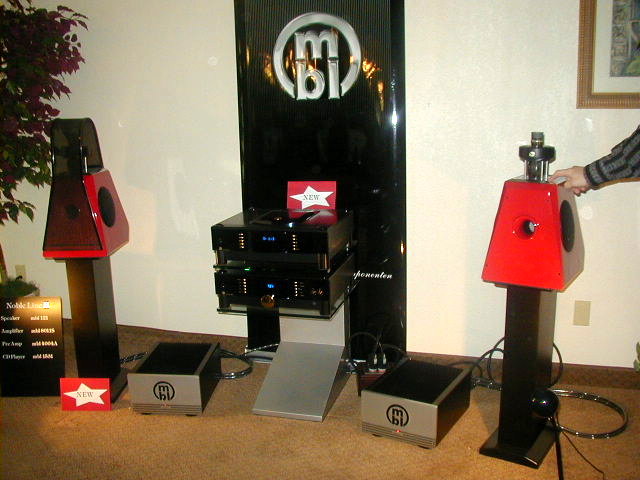 Next was the MBL room. These electronics and speakers sounded very good in my opinion, and were one of the better sounds at the show. They were playing music on their MBL-121speakers, amps were theMBL-8011 monoblocks($9,658), the preamp was an MBL-4004A($2,739 + options), and feeding it all was anMBL-1531 CD player. The sound was lively, detailed and musical.
Next was the MBL room. These electronics and speakers sounded very good in my opinion, and were one of the better sounds at the show. They were playing music on their MBL-121speakers, amps were theMBL-8011 monoblocks($9,658), the preamp was an MBL-4004A($2,739 + options), and feeding it all was anMBL-1531 CD player. The sound was lively, detailed and musical.
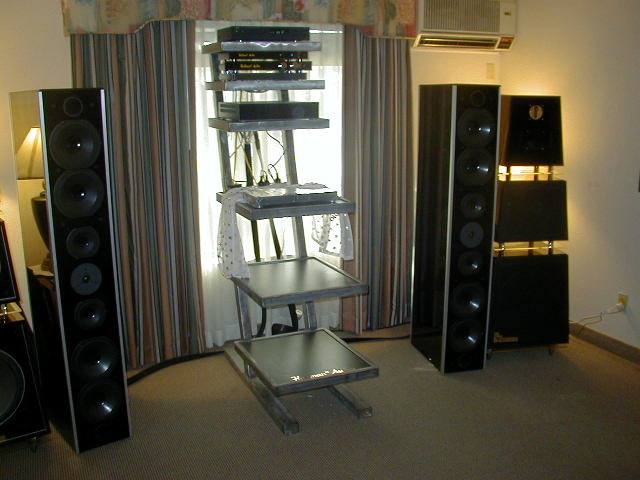 The Hollman Audio room was another one that I enjoyed visiting. The company is named after its precocious Aussie founder Christopher Holland and his longtime friend and technical advisor, Donald Kirkman. TheirMerapi power amps feature three modes of operation: single phase AC, three phase AC, and “Flatliner” DC. The Esoterikpreamp uses a battery-powered power supply. Holland was showing off two huge loudspeaker systems: a seven-driver tower called theDeliverance and an even more massive three-piece modular design called the Sphinx. Both designs use an active crossover. Holland is very knowledgeable about his craft and even had a hint of witty cynicism. Once you got past his gruff exterior, there was no denying the musicality of his speakers and his electronics. He played a wonderful CD of an Australian a capella group whose name I am trying to find out. I may not be able to afford those speakers but I want to buy that CD.
The Hollman Audio room was another one that I enjoyed visiting. The company is named after its precocious Aussie founder Christopher Holland and his longtime friend and technical advisor, Donald Kirkman. TheirMerapi power amps feature three modes of operation: single phase AC, three phase AC, and “Flatliner” DC. The Esoterikpreamp uses a battery-powered power supply. Holland was showing off two huge loudspeaker systems: a seven-driver tower called theDeliverance and an even more massive three-piece modular design called the Sphinx. Both designs use an active crossover. Holland is very knowledgeable about his craft and even had a hint of witty cynicism. Once you got past his gruff exterior, there was no denying the musicality of his speakers and his electronics. He played a wonderful CD of an Australian a capella group whose name I am trying to find out. I may not be able to afford those speakers but I want to buy that CD.
A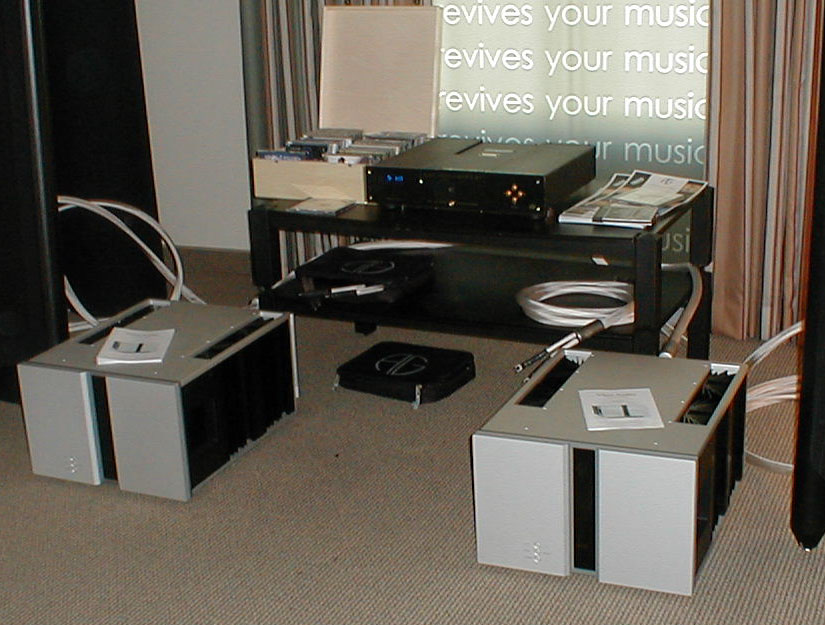 nother one of my favorite rooms was the Vitus Audio room. TheirSM-100 mono amplifiers ($45,000) looked awesome and were hooked up to the large Sound Labs Ultimate-1 electrostatic speakers ($29,700) via the Argento Audio Serenity Series cables. Unfortunately, their digital front-end and preamp were held up in customs and did not make it to the CES. In spite of that, the amps drove the Sound Labs wonderfully with an Electrocompaniet CD player as the source. Music sounded warm and natural and really made the big electrostatics shine. I can’t even imagine how wonderful the amps would have performed if they had their own preamp in front of them. I hope to have a review sample as soon as possible.
nother one of my favorite rooms was the Vitus Audio room. TheirSM-100 mono amplifiers ($45,000) looked awesome and were hooked up to the large Sound Labs Ultimate-1 electrostatic speakers ($29,700) via the Argento Audio Serenity Series cables. Unfortunately, their digital front-end and preamp were held up in customs and did not make it to the CES. In spite of that, the amps drove the Sound Labs wonderfully with an Electrocompaniet CD player as the source. Music sounded warm and natural and really made the big electrostatics shine. I can’t even imagine how wonderful the amps would have performed if they had their own preamp in front of them. I hope to have a review sample as soon as possible.
Impressive Showing
The Speaker Art room was another haven for good music and good sound which featured Bob Gross’ Super Clef Clef loudspeakers (S1,800), Robert Richardson’s Tek Line cables and Jeffrey Hagler’s Sonic Euphoria preamp ($1,200 Single Ended – $1,800 Balanced). This is a passive preamp and one look at the inside, through the clear top cover, shows that a lot of attention to detail and a ton of point-to-point wiring was done. It looked like no other passive preamp I’ve seen the inside of before. The sound was great and I really enjoyed listening to music on that system.
Good music could also be had in the Consonance Audio/Buggtussel room, which featured Consonance electronics and CD player, and the Buggtussel Lemniscusspeakers ($7,200). I enjoyed chatting with Kevin Blair and even learned the true meaning of the name of his company. I found the music to sound natural and musical, with bass that was tight and tuneful. I wanted to spend more time just listening there. If you get a chance, give these speakers a listen.
Lots of good music was heard coming from the 47 Laboratory room. 47 Lab’s U.S. Distributor Yoshi Segoshi, or “Yoshi-san” as he was respectfully referred to by one of our associates, really had the room set up nicely. We enjoyed music through a system featuring the engaging and tall Cain & Cain Studio BEN-ES speakers, RS Laboratory RS-AI Tonearm ($980) on a Rega Planar 9 for vinyl and the 47 Labs PiTracer CD transport ($25,000) andProgression DAC ($2,700) for digital. Amplification was via47 Lab’s Gaincard ($1,500) and Input Chooser ($750). Each piece was bolstered by its own massive external power supply. 47 Labs pieces are relatively diminutive in size but this belies the musicality and power that the system generates.
Back to that RS Labs tonearm for a moment. I have heard early versions of the Rega Planar 9 turntable on numerous occasions and have never been overly impressed by it. But with the RS Labs tonearm, and a Miyabi cartridge, the Planar 9 rendered a performance that was far more musical than it had been with any of the early Rega arms. I have yet to hear the P9 with the new RB1000 tonearm but have been told that it is a big improvement. Anyone with a P9 would do well to look into the RS Labs tonearm. The combination is excellent.
Best At Show
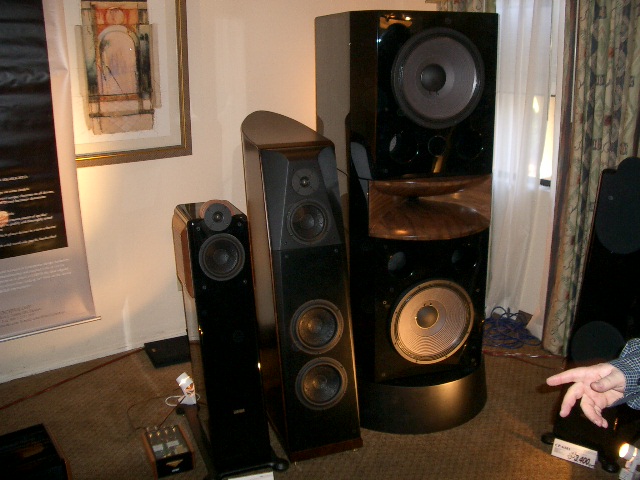
For me, one of the “best sounds” I heard at the show came from the Usher Audio room. Stan Tracht and his brother Carter were very accommodating and put up with all of my speaker-changing and music selection requests. The system featured an Usher CD-100 CD player splitting duty with an Esoteric DV50 SACD player ($5,500) as the source components. The rest of the system was the sleek and stylish new CP-6311 loudspeakers ($2,100) driven by the P-307 ($1,980) preamp andR-1.5 ($2,200) 160 watt Class A amplifier. Selection after selection was presented with openness, musicality, and—a rarity at shows like this—musical involvement. Hearing tracks that I was intimately familiar with produced the spine tingling effects I had come to know when listening to them at home and made the experience that much more enjoyable. The 6311 is part of the new “6 Series” of loudspeakers from this Taiwanese speaker giant. What’s more exciting is that the 6311 is the smallest in the series, which also includes the CP-6371 ($2,900) and CP-6381 ($3,400). The cabinets come finished in a gorgeous high-gloss black, white, or silver, and feature elegantly sculpted wood accents.
Another one of my “best sounds at the show” was to be found in the Bertr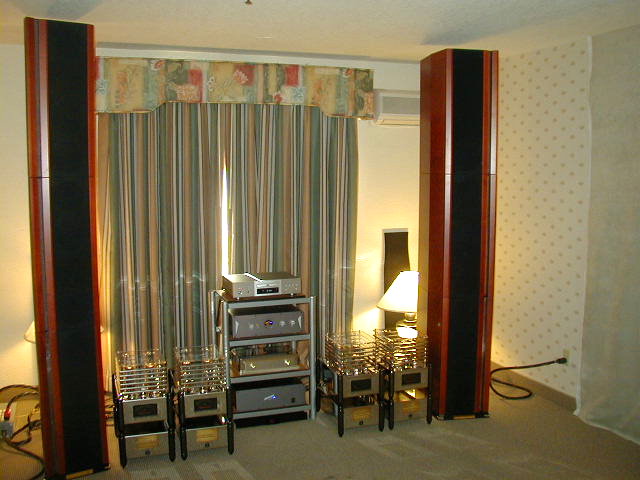 and Audio room. Jay Bertrand played music through the wonderful Dali Megaline speakers ($40,000), driven by the exotic looking Ming Da MC300B-845 tube monoblock amplifiers ($12,500) and The Messenger preamplifier. The source was a Xindak SCD-2 tubed SACDplayer ($1,895) and a Zanden Model 5000 Mk III DAC. Connecting the setup were theXindak Gold speaker cables($1,850/meter pair) and interconnects ($1,450/meter pair). For smooth presentation and large-scale dynamics, this was the place to be.
and Audio room. Jay Bertrand played music through the wonderful Dali Megaline speakers ($40,000), driven by the exotic looking Ming Da MC300B-845 tube monoblock amplifiers ($12,500) and The Messenger preamplifier. The source was a Xindak SCD-2 tubed SACDplayer ($1,895) and a Zanden Model 5000 Mk III DAC. Connecting the setup were theXindak Gold speaker cables($1,850/meter pair) and interconnects ($1,450/meter pair). For smooth presentation and large-scale dynamics, this was the place to be.
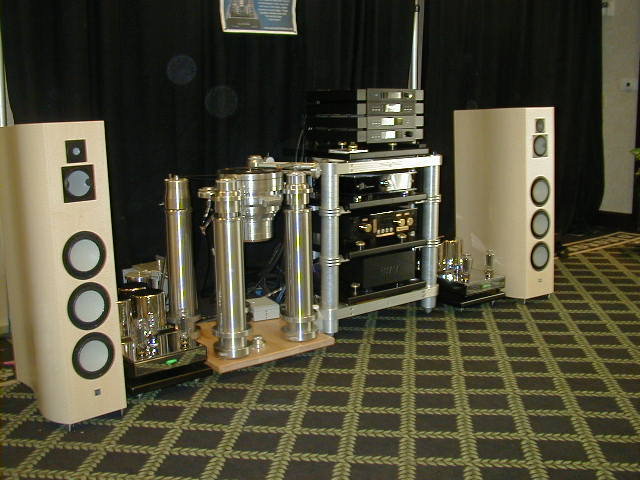
Also falling in the category of “best sounds at the show” were the two systems run in the Acoustic Dreams room. The main system featured the Lumenwhite Whitelight ($40,000) and Ayon Audio 52-B Reference amplifiers. A digital front end from dCS and the VYGER Indian Signature turntable handled the analog. The smaller system was Ayon’s Dragon S speakers ($19,225) driven by an Ayon Sunrise integrated amplifier ($6,900).
A george mark audio technologies CD player (price unknown) and DAC/preamp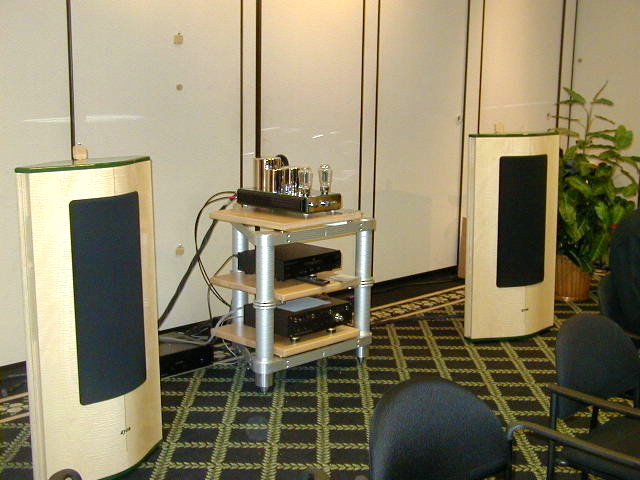 ($5,900) completed this system. All equipment sat on Acoustic Dreams’ own gorgeous custom-built equipment racks. As a bonus,Acoustic System’s Frank Tchangstopped by to demonstrate hisResonators: tiny metal bowls that sit atop little wood blocks. When positioned correctly they can have an interesting effect on the music’s sound. I had previously heard the main set-up (sans resonators) at a Chicago Audiophile Society meeting last year and it sounded as stunningly good then as it did here.
($5,900) completed this system. All equipment sat on Acoustic Dreams’ own gorgeous custom-built equipment racks. As a bonus,Acoustic System’s Frank Tchangstopped by to demonstrate hisResonators: tiny metal bowls that sit atop little wood blocks. When positioned correctly they can have an interesting effect on the music’s sound. I had previously heard the main set-up (sans resonators) at a Chicago Audiophile Society meeting last year and it sounded as stunningly good then as it did here.
Best Sound at Show!
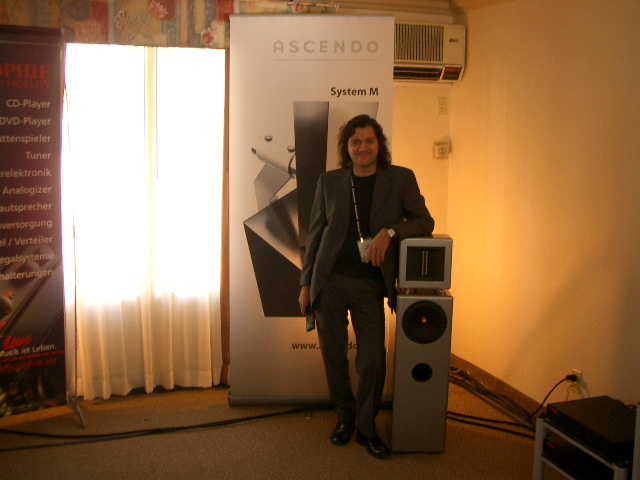
My favorite sound at the show came from the Ascendo Audio room. Clement Perry has written at length about the virtues of this German loudspeaker company and now I know why. The System Z-F3 is outfitted with an 8” midrange/woofer and a ribbon tweeter that simply dazzles. I asked designer Jurgen Scheuring (above) to play Can’t Help Lovin’ That Man from the Ray Brown Trio’s “Live At The Loa.” This was as close as I’ve come to calling something “sonically holographic.” Airy, spacious, and detailed were just a few of the words that popped into my head while listening.
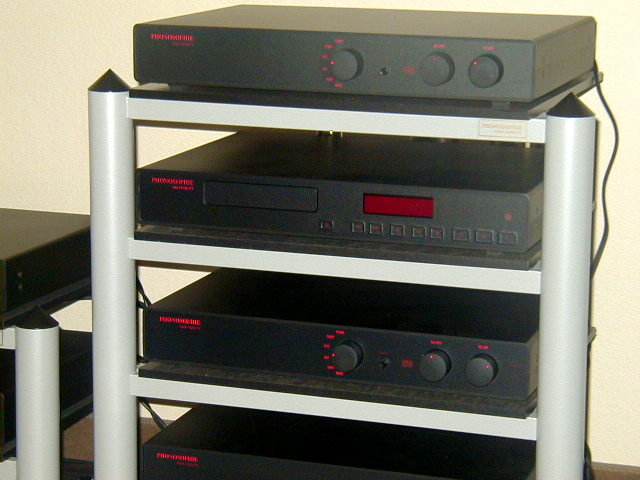 But continued listening told me that some of the credit for this glorious sound had to be given to the electronics from a relative newcomer to the U.S.,Phonosophie. The system comprised of Phonosophie’sImpuls 2 CD player, BI-Control 2 preamplifier, BI-Amp 1-2 integrated amp and a pair of Spike power amplifiers with Power Control 3 power supplies. Something special was definitely going on here. To put it plainly: it made music from every CD sound as though the performance was somehow inside the listening room. Equally delightful was getting to know the man behind these splendid electronics, Ingo Hansen. One look at the Phonosophie gear and you’ll swear it’s a close relative of the great Naim Audio gear. Another interesting tidbit is that Linn’s Lingo power supply was named after Hansen. Lingo for Ingo.
But continued listening told me that some of the credit for this glorious sound had to be given to the electronics from a relative newcomer to the U.S.,Phonosophie. The system comprised of Phonosophie’sImpuls 2 CD player, BI-Control 2 preamplifier, BI-Amp 1-2 integrated amp and a pair of Spike power amplifiers with Power Control 3 power supplies. Something special was definitely going on here. To put it plainly: it made music from every CD sound as though the performance was somehow inside the listening room. Equally delightful was getting to know the man behind these splendid electronics, Ingo Hansen. One look at the Phonosophie gear and you’ll swear it’s a close relative of the great Naim Audio gear. Another interesting tidbit is that Linn’s Lingo power supply was named after Hansen. Lingo for Ingo.
More Good Stuff
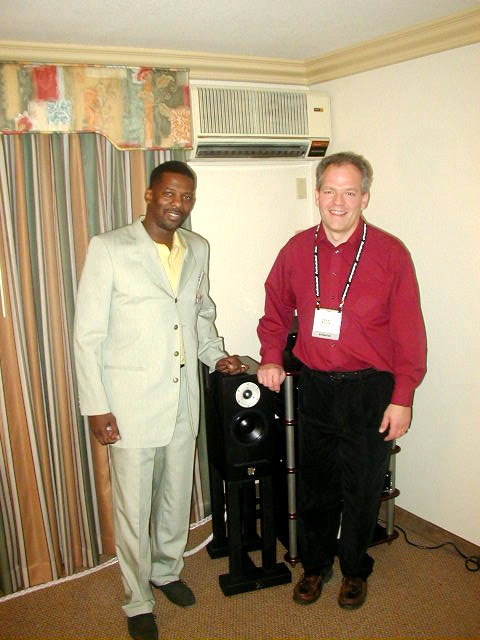
There were many other fine and notable systems that deserve to be called out. These were rooms that had smaller, simpler set-ups compared to most of those that I’ve mentioned so far, but which I felt were still very musical and thoroughly enjoyable. TheEscalante Design room (photo right show’s Budge posing with ST’s fearless leader, CP),featured Tierry Budge’s newest speaker design called thePinyon, which has a musical and engaging sound that will be well worth seeking out. In the Audio Oasis room, George Tordai’sAudio Zone AMP-1 was being fed by a Copland CD player and driving the highly musicalReference 3A speakers. Credit also had to be given to theDynamic Design cables, which George said were dynamic and neutral enough to allow his amp to really show its strengths. These excellent cables are marketed by my fellow Chicago-area audiophile, Don Smith, and serve as a reference in my system. The Zingali Loudspeaker room featured a host of stunning Italian-made speakers, but the ones that caught my attention were the small Cinema M monitors paired with their OSC 206 subwoofer. A Viva Audio integrated amp and the Lector CD player drove them to astonishingly clear musical levels with surprising bass control.
The Usual Suspects
There were other rooms that I felt sounded good but which I won’t go into with great detail, mostly because they seem to always have a nice sound and also because I want to make sure some of the rooms that wouldn’t normally get mentioned, got some press. The Halcro, Jeff Rowland Design Group, Edge Electronics, Gryphon, and Joule Electra rooms all produced great sounds as they typically do. Burmester also had an exceptional sounding room and the equipment, as always, was an attention grabber. We were grooving along, until they went multi-channel and started playing music through a center channel that did not seem to image very well. Nothing’s more annoying than knee-level vocals.
Multi-channel Madness
To borrow a phrase from my brother’s hero, Dennis Miller, “Now I don’t want to get off on a rant here,” but the center channels used in some of the rooms were just not necessary. Not just in the Burmester room; in most rooms where they attempted to demonstrate multi-channel sound, the music sounded better in a two-channel setup. When some rooms played music from a small ensemble or trio, with the center channel in place, it seemed as if part of the stage had been removed and was instead replaced with something even more artificial. The transition is rarely seamless. Some rooms also tried to play bass-heavy synthesized rap music (sans vulgarity) and the problem was even more glaring. I just feel that if you have speakers capable of good imaging, you simply don’t need a center channel, especially in a normal-sized room. I do feel center channels work fine for movies, but for music it’s just a further step away from reality and not closer to it. Of course that’s just my opinion, I could be wrong.
Last But Not Least
In the Von Schweikert/VAC/Oracle room, the towering new VR-11 loudspeakers ($125,000) were being demonstrated and my feelings on the sound were sort of a mixed bag. Twice I heard music in that room that just wasn’t quite right. But after a third listen, adjustments were made and the speaker’s sound improved dramatically. I’m not sure what the problem was early on, but during one demo someone did suggest a bass level adjustment. I’m not sure if that is what did the trick, but once this system was dialed-in, the sound was phenomenal: huge stage presentation, explosive dynamics, and spot-on imaging. The featured system in the room was the Oracle CD-1000 transport ($7,500) and DAC 1000 ($7,500) along with the Valve Amplification Company Renaissance preamp and VAC Phi 220 monoblock amplifiers. Not only were these pieces absolutely gorgeous to behold, but they sounded wonderful as well. The VAC electronics in particular sounded much better than when I last listened to them, and they were fine sounding even then. They were powerful and detailed, with fast transient response and tight, extended bass. Kudos to Kevin Hayes.
All in all, it was a gratifying experience and I’m already making plans for next year’s show. I was not able to make it to all of the rooms and if I missed anyone, hopefully I’ll get you the next time.
![]()
Stereo Times Masthead
Publisher/Founder
Clement Perry
Editor
Dave Thomas
Senior Editors
Frank Alles, Mike Girardi, Russell Lichter, Terry London, Moreno Mitchell, Paul Szabady, Bill Wells, Mike Wright, and Stephen Yan,
Current Contributors
David Abramson, Tim Barrall, Dave Allison, Ron Cook, Lewis Dardick, John Hoffman, Dan Secula, Don Shaulis, Greg Simmons, Eric Teh, Greg Voth, Richard Willie, Ed Van Winkle, Rob Dockery, Richard Doron, and Daveed Turek
Site Management Clement Perry
Ad Designer: Martin Perry





Be the first to comment on: CES2004 Mike Wright